The directions to make the dough requires a bit of mixing and calls for a stand mixer or a food processor that has a paddle. If I had to mix this recipe by hand, it would require 10 to 15 minutes of vigorous beating by hand. Personally I find using a stand mixer much easer. Be prepared for an irresistible cheesy bread aroma wafting from the oven while the bread rolls bake. I used a one and three-quarter inch cookie dough scooper to scoop the dough out of the bowl and bake them into small balls. If you use a tablespoon or a small ice cream scooper, you may need to dip the utensil into a bowl of water between scoops to keep the dough from sticking. The dough didn't stick using a cookie dough scooper. Cassava flour when baked is not the same as wheat flour. It is more moist inside and not as dry as wheat bread roll. The bread rolls taste good and the DH likes them. Next time I make them I would add a bit of dried dill or basil to the dough batter.
 |
| Dough cooling in the saucepan. |
 |
| Eggs being added to the dough. |
 |
| All ingredients have been added and mixed and now ready to be scooped onto the baking sheets. |
 |
| Scooped onto the parchment paper. |
 |
| Close up. |
1 cup of milk or almond or coconut milk
1/2 cup avocado oil
1 tsp salt
10 ounces (about 2 cups) cassava flour
2 large eggs or vegan eggs
1 to 1.5 cups grated Parmigiano-Reggiano or 1 cup nutritional yeast
DIRECTIONS:
1. Preheat the oven to 450 degrees F. You will need to use two baking sheets so you may have to adjust your racks to fit both in the oven at the same time.
2. Line the two baking sheets with parchment paper or silicone baking mats.
3. Into a medium size saucepan, add the milk, oil and salt. Heat over medium heat, stirring occasionally with a mixing spoon. Remove from the burner when big bubbles start to appear as the mixture is starting to boil.
4. Add the cassava flour to the saucepan and stir with a mixing spoon until it is well combined and it looks like dough. Let it sit for a few minutes so that it starts to cool off.
5. Transfer the dough into a bowl of a standup mix (eg mixmaster) fitted with a paddle attachment. Beat the dough for a few minutes on medium speed until it appears smooth and it cool enough to handle.
6. Keeping the mixer on medium speed, add the eggs into the cooled mixture one at a time. Wait until the first egg is incorporated into the batter before adding the second. You will need to stop the mixer from time to time to scrape down the dough on the sides of the mixing bowl. Mix for a minute to two minutes.
7. If using cheese, beat it in on medium speed and make sure it is incorporated through the dough. You may have to scrape down the sides of the bowl if the dough is sticking to the sides. The dough will be soft and stretchy and a bit sticky.
8. Using a cookie scooper or another favourite scooper, scoop the dough out of the bowl and place onto the parchment paper. The dough will rise a little bit while baking so space out the scoops between the two baking sheets.
9. Place the baking sheets in the oven and reduce the heat to 350 degrees F. Bake for 15 minutes, then rotate the baking sheets. Bake for an additional 10 to 15 minutes until the buns are golden. Remove from the oven and cool for a few minutes before serving or sampling. Makes 24 to 28 buns.
Adapted from the Plant Paradox Cookbook by Steven Gundry.

No comments:
Post a Comment